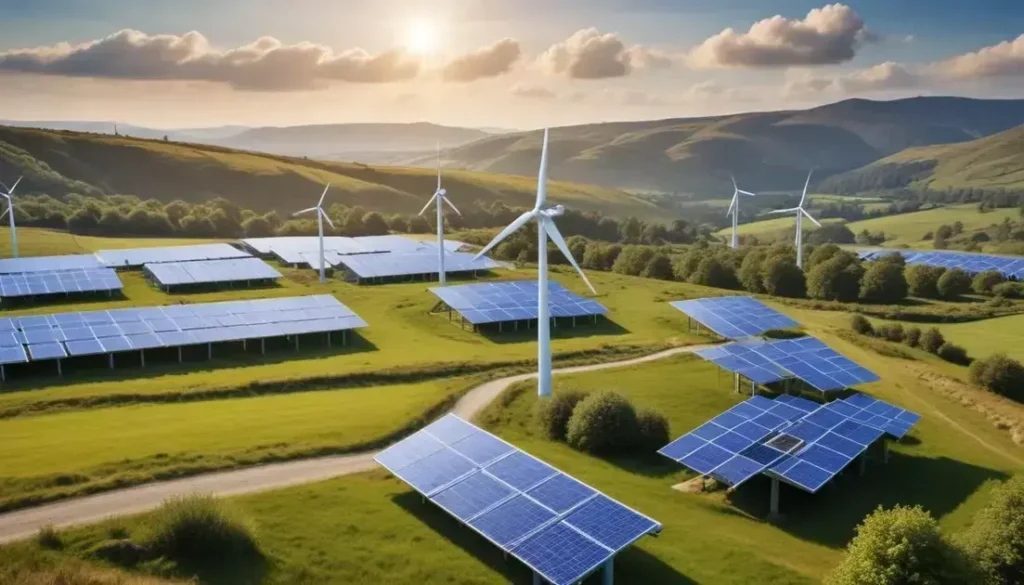Kelp restoration is a critical process that enhances marine ecosystem health by increasing biodiversity, improving carbon absorption, and combating effects of climate change through initiatives that involve advanced technology and community engagement.
Explore how kelp restoration efforts in Australia are using cutting-edge AI technology to combat climate change and restore vital marine ecosystems.
An introduction to Australia’s Great Southern Reef
Australia’s Great Southern Reef is a stunning marine ecosystem that extends over 8,000 kilometres along the southern coast. This vibrant underwater habitat is primarily composed of kelp forests, which play a critical role in supporting biodiversity. These underwater jungles are home to a wide variety of marine species, making it an essential area for conservation efforts.
Kelp forests provide numerous benefits, including acting as a carbon sink, helping to mitigate climate change. They create a habitat for countless organisms such as fish, crustaceans, and other marine life, which rely on the reefs for food and shelter. The reefs also contribute to local economies, especially in fisheries and tourism.
However, climate change, pollution, and other human activities pose significant threats to this precious ecosystem. Rising ocean temperatures and acidification are damaging these vital kelp forests, leading to habitat loss and decreased marine biodiversity. Conservationists emphasise the need for immediate action to protect and restore the Great Southern Reef, utilising innovative solutions like AI technology for monitoring and restoration.
Awareness and education about the importance of Australia’s marine ecosystems are crucial. Encouraging sustainable practices among local communities and businesses can greatly aid in preserving the Great Southern Reef for future generations.
The significance of kelp forests in climate mitigation
Kelp forests play a vital role in climate mitigation by acting as effective carbon sinks. These underwater ecosystems absorb significant amounts of carbon dioxide from the atmosphere through photosynthesis. By sequestering carbon, kelp forests help combat climate change and reduce the overall concentration of greenhouse gases.
In addition to their carbon absorption capabilities, kelp forests provide habitat for diverse marine species. They create an intricate ecosystem where fish and invertebrates thrive. This biodiversity enhances the resilience of marine populations against environmental changes, ensuring ecosystem stability.
Kelp forests also contribute to the ocean’s health by improving water quality. They absorb excess nutrients and pollutants, thus preventing harmful algal blooms that threaten marine life and coastal communities. Healthy kelp forests can also mitigate coastal erosion, providing natural protection against storms and rising sea levels.
As we face the challenges of climate change, restoring and protecting kelp forests is crucial. Conservation efforts that focus on mitigating human impacts can enhance the health of these ecosystems. Engaging local communities in sustainable practices will further bolster the ecological benefits that kelp forests provide.
AI technologies used in kelp restoration
AI technologies are revolutionising kelp restoration efforts by providing innovative solutions that enhance the effectiveness and efficiency of conservation initiatives. These technologies enable researchers to collect and analyse vast amounts of data, allowing for better decision-making in restoration projects.
One significant application of AI in kelp restoration is through remote sensing. Satellite imagery combined with AI algorithms can monitor kelp forest health and growth patterns over time. This data helps identify areas that require intervention, optimising resource allocation for conservation efforts.
Additionally, AI tools support genetic research by helping scientists analyse genetic diversity within kelp populations. Understanding these patterns is crucial for developing resilient strains of kelp that can better withstand the impacts of climate change.
Machine learning models are also employed to predict the outcomes of various restoration strategies. By simulating different scenarios, scientists can identify the most effective approaches to restore kelp ecosystems. AI-driven insights enable more informed management practices, ultimately leading to healthier marine environments.
Through these advanced technological applications, AI is enhancing our ability to protect and restore critical kelp forests in Australia. Emphasising the integration of technology in environmental conservation highlights the potential for sustainable futures.
Collaboration between Google and conservation organisations
The collaboration between Google and various conservation organisations marks a significant step towards enhancing marine ecosystem restoration, particularly for kelp forests. This partnership leverages Google’s advanced technological capabilities, including AI and cloud computing, to address critical environmental challenges.
Through innovative tools and platforms, these collaborations allow scientists to analyse large datasets related to kelp health and growth. By utilising advanced data analytics, conservationists can make informed decisions on the best practices for restoration. This synergy between technology and environmental science creates a powerful alliance aimed at revitalising marine habitats.
One notable initiative involves the implementation of machine learning algorithms to predict the growth patterns of kelp. Such predictions help organisations to better plan restoration efforts, ensuring resources are effectively allocated. This proactive approach not only boosts the health of kelp forests but also enhances biodiversity.
Moreover, Google’s commitment to transparency and open data further fosters collaboration within the environmental community. Sharing insights and data-driven models promotes best practices among conservationists, encouraging a collective effort towards sustainable practices. By combining expertise in technology with ecological knowledge, this collaboration holds the potential to create lasting impacts on marine restoration.
The role of genetic research in kelp propagation
Genetic research plays a crucial role in the propagation of kelp, enhancing the resilience and sustainability of kelp forests. By studying the genetic diversity within kelp populations, scientists can identify traits that enable these plants to thrive in changing environmental conditions.
Through advances in genomics, researchers can assess how kelp adapts to factors such as temperature fluctuations and nutrient availability. This understanding allows for the selection of the most resilient kelp strains for propagation, ensuring that restored forests can withstand climatic stresses and maintain their ecological functions.
Moreover, genetic research facilitates the development of effective breeding programs. Scientists can use techniques such as selective breeding to enhance desirable traits in kelp, including faster growth rates and improved reproductive success. These proactive measures are essential for scaling up restoration efforts in areas devastated by environmental degradation.
Another vital aspect of genetic research is the establishment of *seed banks*. These repositories store genetic material from diverse kelp populations, preserving the genetic information necessary for future restoration projects. By maintaining genetic diversity, these seed banks can provide a robust foundation for restoring kelp forests as environmental conditions evolve.
Examples of successful restoration initiatives
Successful restoration initiatives have emerged worldwide, showcasing effective strategies for revitalising kelp forests. One notable example is the Southern California Kelp Recovery Project. This initiative has implemented targeted restoration techniques to combat the decline of kelp ecosystems due to factors like overfishing and climate change. By focusing on habitat restoration and community engagement, the project has successfully increased kelp populations in degraded areas.
Another inspiring case is the Great Southern Reef Restoration Project in Australia, which aims to restore kelp habitats along the southern coast. This initiative combines scientific research, local knowledge, and community action to enhance the resilience of kelp forests. By using innovative methods, such as kelp nurseries and genetic studies, the project has shown positive impacts on marine biodiversity and local fisheries.
The Maine Coast Kelp Project also highlights successful restoration efforts in the United States. By focusing on sustainable aquaculture practices, this initiative has developed a profitable kelp farming industry while fostering ecosystem health. The project promotes environmental awareness and provides economic opportunities for coastal communities.
These examples illustrate the significance of collaboration among scientists, policymakers, and local communities in restoring kelp ecosystems. Each initiative not only focuses on biological recovery but also prioritises social engagement and environmental education.
Challenges faced in kelp conservation
Kelp conservation faces numerous challenges that threaten the health and sustainability of these vital ecosystems. One major issue is climate change, which leads to rising ocean temperatures and acidification. These changes can severely impact kelp growth and health, making it difficult for forests to thrive.
Additionally, excessive nutrients from agricultural runoff can cause algal blooms. These blooms block sunlight, hindering kelp photosynthesis and ultimately leading to declines in kelp populations. Mitigating nutrient pollution remains a significant hurdle in conservation efforts.
Overfishing is another challenge that affects kelp ecosystems. The removal of key grazer species, such as herbivorous fish and sea urchins, can result in unchecked kelp consumption, drastically reducing kelp biomass. Implementing sustainable fishing practices is critical to maintaining the balance within these ecosystems.
Moreover, human activities such as coastal development and pollution further exacerbate the decline of kelp forests. Habitat alteration can disrupt the natural processes vital for kelp reproduction and growth. Effective conservation strategies must address these challenges through community engagement, policy implementation, and scientific research.
Future outlook for marine ecosystem restoration
The future outlook for marine ecosystem restoration is increasingly optimistic, driven by advancements in technology, scientific research, and community engagement. As awareness of environmental issues grows, more initiatives are being launched to restore vital resources, including kelp forests and coral reefs.
Innovative techniques such as biotechnology and genetic research are being utilised to enhance the resilience of marine species. By breeding individuals with desirable traits, conservationists can propagate stronger populations that are better equipped to withstand the impacts of climate change and other environmental stressors.
Additionally, the integration of artificial intelligence in monitoring and data analysis is transforming restoration practices. AI can help predict ecosystem responses to various restoration approaches, enabling more effective decision-making. This technology allows scientists to gather and analyse vast amounts of data in real-time, improving the speed and accuracy of assessments.
Furthermore, community involvement in restoration efforts is expected to increase. Many local organisations are recognising the importance of public participation in conservation initiatives. By fostering a sense of stewardship, communities can play a vital role in maintaining and protecting marine ecosystems for future generations.
In Conclusion, the Future of Marine Ecosystem Restoration
The future of marine ecosystem restoration is filled with hope and innovation. With new technologies and techniques emerging, there is a real opportunity to heal our oceans and protect vital habitats. The integration of science, technology, and community participation will play a key role in these efforts.
By focusing on resilience, we can ensure that ecosystems like kelp forests thrive in the face of challenges such as climate change and pollution. Local communities and conservationists can work together to implement effective strategies that benefit both the environment and local economies.
As awareness grows and more people get involved, we can look forward to healthier marine ecosystems that will be enjoyed by future generations. Together, we have the power to make a difference and create a sustainable future for our oceans.
Frequently Asked Questions
What are kelp forests and why are they important?
Kelp forests are underwater ecosystems formed by large brown algae, providing habitat for various marine species and contributing to carbon absorption.
How does climate change affect kelp forests?
Climate change causes rising ocean temperatures and acidification, which can stress kelp and diminish their growth and health.
What role does technology play in kelp restoration?
Technology, such as AI and remote sensing, helps monitor kelp health and predict outcomes for restoration initiatives, making efforts more effective.
How can communities get involved in kelp conservation?
Communities can participate by engaging in local restoration projects, advocating for sustainable practices, and educating others about the importance of kelp forests.
What are some successful examples of kelp restoration initiatives?
Successful initiatives include the Southern California Kelp Recovery Project and the Great Southern Reef Restoration Project, which highlight community and scientific collaboration.
What are the main challenges faced in kelp conservation?
Major challenges include climate change, nutrient pollution, overfishing, and habitat destruction, all of which threaten the health of kelp ecosystems.


